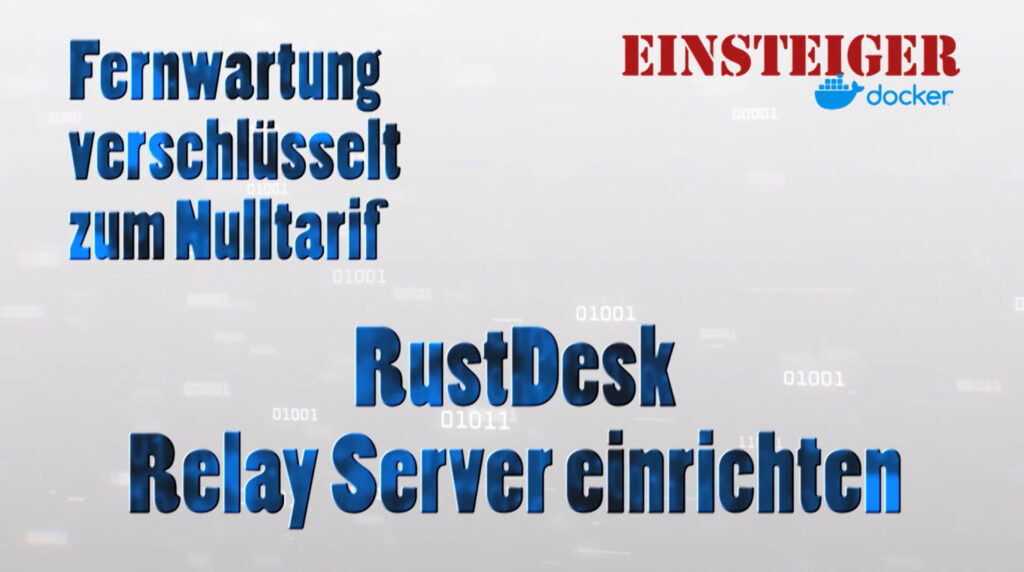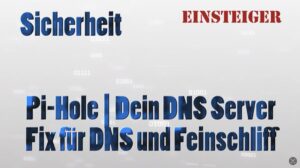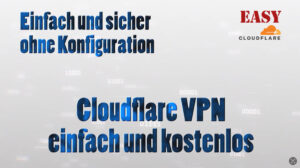Set up RustDesk Relay Server | Docker | Encryption and zero tariff
The remote maintenance alternative RustDesk is an ingenious program, so you can set up your RustDesk Relay Server and use it free of charge.
Video: Set up RustDesk Relay Server | Docker | Encryption and zero tariff
Language: 🇩🇪
☝️ Use YouTube subtitles for all languages.
Die Datei: docker-compose.yml
You can choose a directory on your hard disk as the storage location. In any case, it should be a new and empty directory, as the “volume data” data of the container is stored in the subdirectory in the “/rd-data” directory.
The start is done with:
docker-compose up -dAlternatively, create a “stack” in the PORTAINER
Of course, as shown in the video, you can enter the content of the “docker-compose.yml” in a “stack” in the container to create and start the containers. I also show this in the video.
# docker-compose.yml
# version: '3'
services:
# -----------------------
# RustDesk Relay Server
# -----------------------
hbbs:
container_name: hbbs
ports:
- 21115:21115
- 21116:21116
- 21116:21116/udp
- 21118:21118
image: rustdesk/rustdesk-server:latest
environment:
- ALWAYS_USE_RELAY=Y
command: hbbs -r DeineDomainOderIPadresse:21117
volumes:
- ./rd-data:/root
depends_on:
- hbbr
restart: unless-stopped
hbbr:
container_name: hbbr
ports:
- 21117:21117
- 21119:21119
image: rustdesk/rustdesk-server:latest
command: hbbr
volumes:
- ./rd-data:/root
restart: unless-stopped
networks:
security:
driver: bridge- I have marked you, in the docker-compose.yml, yourDomainOrIPaddress here you enter your domain such as “rustdesk.example.de” or your IP address.
Wenn Du über das Internet Verbindung zu deinen RustDesk Server herstellen willst, musst Du die Internet Adresse auf deinen PC weiter leiten, auf dem der RustDesk Server ausgeführt wird.
DynDNS and similar services usually no longer work, as most Internet connections run via NAT. In the article NAT | Access to the home network I show step by step how you can set up a tunnel to your home network in order to access it. So that you, or your customers, can reach your RustDesk server. - I have marked security as a further point. The two containers “hbbs” and “hbbr” are listed under this name, comparable to a grouping. You can change this to “rustdesk”, “rd-server” or any other term you like.
- S6-overlay based images. If you need a different image, possibly AMR or i386 etc., you can find them under this link at github.com.
Firewall, you need these ports for the Internet
hbbs needs the ports
– 21115:21115
– 21116:21116
– 21116:21116/udp
– 21118:21118
hbbr needs the ports
– 21117:21117
– 21119:21119
So you release the ports
The easiest way to define the ports:
21115 bis 211119 auf TCP/IP
and the port 21116 additionally to UDP
In this way, you only have two entries that are relevant for the RustDesk server. A stumbling block here is that the router normally takes care of the firewall and regulates this. Many systems (Windows, for example) also have a firewall running. If this does not work, check both firewalls.
The Keys
We have muted the container data in the directory “/rd-data” (or the directory name you have used). You will find the files there, among others:
id_ed25519
id_ed25519.pub
id_ed25519 contains the private key, which remains with you alone, it is best not to open the file at all 😁👍
id_ed25519.pub contains the public key. The Kleines need this to connect to the server. Please make a note of it now, as we will need it shortly.
RustDesk Client configuration
Follow the video to see how to enter the server in the RustDesk application on the client under Settings -> Network.
First you have to unlock the “Network settings“, click on the blue bar of the same name at the top.
Under SERVER-ID: enter your domain or IP address as you have configured it in the “docker-compose.yml” file.
Under Key: Enter the key that you have noted from the file “id_ed25519.pub”.
Finally, click on Apply at the bottom right.
… DONE, that’s it.
Note / Hints !
If you are connected to your RustDesk server, you can only connect to clients that are also connected to your (or the same RustDesk server).
If you want to connect to a client system that is not connected to your server, you can only do this if you delete the server settings under Settings -> Network. Alternatively, the client can of course also log on to your RustDesk server.
You can only use one environment at a time, at least at the moment. Server or no server, mixed operation is not possible.
Klient Setup with server setting
It is possible to create a setup file that the customer, friend or acquaintance can call up to connect directly to your server.
I will go into this in the next article.
Link to support / donation for the channel
PayPal Link
Bank transfer, Bitcoin and Lightning
Docker #Portainer #RustDesk #RustDeskServer #RemoteService #RemoteSoftware #RemoteMaintenance




Pingback: RustDesk Server Klient Setup with Relay Server connection | Michael Klissner